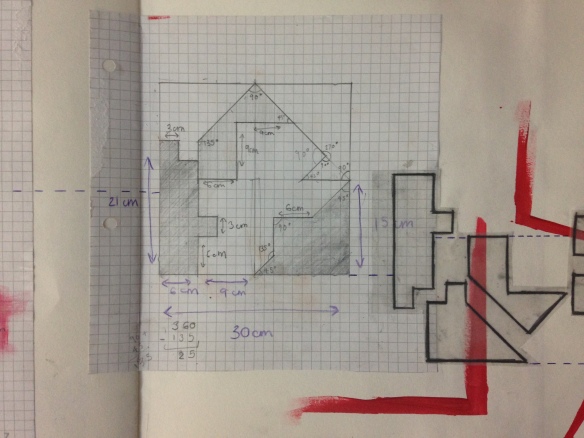Inspired by David Rhys Jone’s work, we have decided to incorporate a centre piece within our Machine Aesthetic themed room. This will be placed on the table, which will be made of scaffolding wood. The idea is to create an interlocking shape; inspired by the connecting of different components within machines, much like cogs working together.

Initially I played around with clay, chopping up leather hard chunks at various angle to see what happened. And adding impressions of nuts and bolts etc.
Realising that I wanted a table piece which be around 30 cm squared and 15 cm tall, I wouldn’t be able to make a solid piece out of clay; as it would explode in the kiln during bisque firing. I would have to make it hollow.
I then thought about how I would split the sections of this table piece up. And it was then I had a light bulb moment. To make a ceramic puzzle, which, when taken apart would reveal images of the machinery used to construct the very items in our room!
After experimenting with various angles and lines, I settled on a square which would be split up into six units. These unique shapes would form a puzzle. Instead of the piece just pulling apart, it involves interlocking shapes; something quire challenging to make. I am still not entirely sure how I’m going to create this.. whether to go the casting route or slab construction… we will see.



Accurate Measurements of the centre piece. This is important for me to get right; otherwise the puzzle pieces will not slot together.


Blue foam maquette with pictures I wish to place as decals on the final ceramic piece.
And then there’s the spoons! I’ve literally never made anything quite like cutlerly before, so I’ve definitely set myself up for a challenge. But without a challenge there’s no fun to be had. And I will potentially develop a new skill from this- I will be able to make spoons!
I’ve looked at a few designers, some being on Etsy and others on instagram… These are the ones I particularly like:


I particularly like this angular spoon. Rather like a stirrer. The function of this spoon is very limited-could maybe pick up a few sugar granules- but it looks great!
Keeping the industrial feel, I’m working with terracotta, It’s a great clay to sculpt with and records textures well, especially when paired with oxides after bisque firing. I think, rather than make, say 6 spoons individually, I will make one prototype and use that as a master copy and make a cast of it. That way, all the spoons will be the same shape and size. Since this is based on the machine aesthetic, I think it’s important to keep a regularity within the spoons, much like things would be repetitively manufactured using machines in a factory.

Image taken from drawings in my sketchbook

My first ever experimental spoons. These are quite small, smaller than a regular tea spoon.

Some more detailed sketches of possible spoon shapes

Second batch of experimental spoons, still wasn’t happy with these shapes, asking the others what they think of them. They liked the far right hand one.














 Eunjae Lee applies the machine aesthetic within ceramics. This is called Silent Machine and it is a tea set. It is inspired by the components of an engine.
Eunjae Lee applies the machine aesthetic within ceramics. This is called Silent Machine and it is a tea set. It is inspired by the components of an engine.